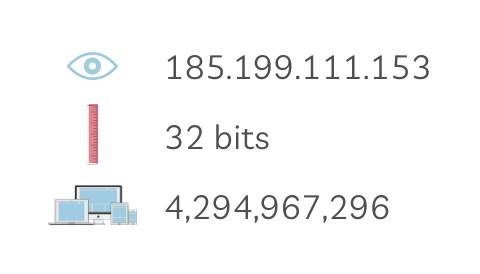[study notes] IP Address
Every device needs a label to be able to communicate with others via a network, this label is called Internet Protocol Address (IP Address). It is a unique identifier, but not necessarily permanent. Most devices don’t need a static IP address, those are needed when external applications need to have this one specific address stored. Instead we’re usually using dynamic IP addresses, they’re assigned by the network and frequently change, making it more difficult for unwanted requests to reach your device.
IPv4

At first, the IP Address looked only like this 185.199.111.153. That’s an IPv4
(Internet Protocol Version 4) format. It’s a sequence of 4
numbers ranging from 0 to 255 separated by dot. When translating it to binary amounts to 32 bits.
The maximum number of numeric combinations within this format is 4.294.967.296.
IPv6

Over the past decades, the number of devices connecting to the internet increased rapidly and
suparssed the amount of possible unique IPv4 addresses, so we had to come up with a new format. The
IPv6 (Internet Protocol Version 6) has a theoretical maximum
of ~340.282.366.920.938.463.463.374.607.431.768.211.456, we’re confident that this number will
not be reached any time soon (probably never). It amounts to 128 bits and looks like:
2001:0db8:85a3:0000:0000:8a2e:0370:7334.